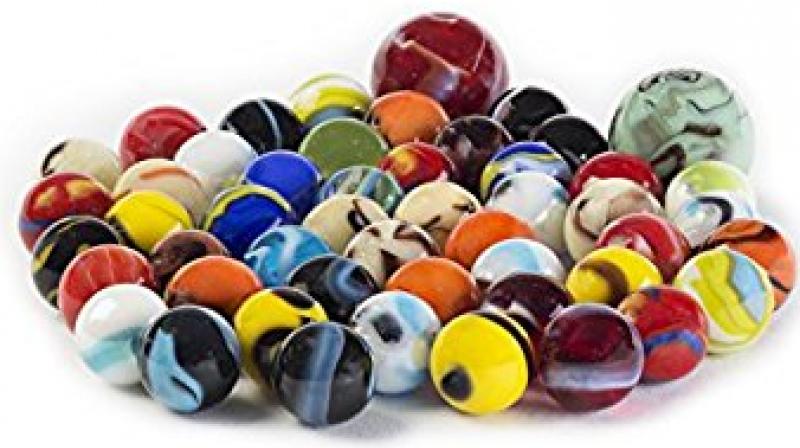Spinning like a top, have we lost our marbles?

There is an unpredictable disconnectedness about how an idea sprouts. It’s a Sunday morning, I am wallowing in a hot shower, head lathered with shampoo, eyes tightly shut to keep the suds out. I am bathroom singing, as is my wont, a snatch from an old pop song, ‘Top of the world’, a ‘70s hit for The Carpenters. Here’s where the disconnectedness kicks in. In an illogical association of ideas, the word ‘top’ in that song sets me thinking about spinning tops. You know, those conical shaped, colourfully painted wooden thingummies with a nail at the end, that comes with a length of string that you wind tightly round the serrations and release to the earth with force, for it to spin like a mad thing. It takes great skill and expertise to ‘spin the top’. We called it bambaram in colloquial Tamil. A superbly balanced, handcrafted work of art.
In our childhood days, when we visited our family village for holidays, with an assortment of relatives from the clan, the spinning top was an integral part of our leisure arsenal. The nail I referred to had to be sharpened such that the bambaram became a lethal instrument, and the skilful player, in one balletic movement, released his top aimed at a rival top still spinning, knocking it out for the count. The expert top spinner could even make it hum in a distinctly musical drone. Onlookers and passers-by had to be on guard, lest one of these colourful missiles should decapitate a toe or two. An uncle of mine narrated a case of a bambaram released erratically and literally nailing a bystander’s head. Mentally maimed for life, the poor victim couldn’t tell his top from his bottom after that! Perhaps the story is apocryphal, but village tales are like that - tall. The moot question is, whatever happened to the spinning top? One hardly ever sees it anymore.
Speaking of tops, my mind turns naturally to marbles, those lovely glass golis with striking coloured patterns inlaid in them. We played all sorts of marble games. Even during my school days in the ‘60s, playing marbles was a hugely popular sport among the boys. And we could play it whenever we had time to spare. Most of the boys were invariably to be seen with hands in their pockets jangling their precious clutch of marbles, only to be sternly chided by our teachers. Among the boys, ribald remarks would vary from, ‘What’s the score?’ to ‘Playing pocket billiards, are we?’ and so on.
However, the actual playing of marbles, rather like spinning the top, involved considerable skill, and only a few were truly adept at it. There were two marble games we played - the first, where you took aim and threw the marble, delicately poised between your forefinger and thumb, at your rival's marble, squinting the while to aid accuracy. If you hit the rival marble, you win that round and get first strike next up. If you miss, your opponent takes over. A domestic adaptation of poor man's snooker, if you like - without the cues and the green baize table. American novelist J.D. Salinger, in his novella Seymour - An Introduction, argues lucidly against the futility of taking aim, opining that you will never strike the target if you consciously aim to hit. A kind of inverse Zen logic!
A more sophisticated marble game involves squatting, and in a complicated manoeuvre with your index and middle fingers employing both hands, you release the marble at great velocity to smash a rival marble to smithereens - a common or garden variety of archery, except that your fingers are the bows and the marbles, the arrows. There are many variants to playing marbles which call for superb hand eye coordination. Those who were good at it invariably excelled in all sports. Incidentally the loser, acrimoniously, had to forfeit his marbles, amidst wailing and gnashing of teeth. Again, the rhetorical question. Why is no one playing marbles anymore? Has it become one with the dinosaur?
We move on to gillidanda. I am not at all sure if there is an English equivalent to this unique rural pastime. The implements used to play this game are two rounded pieces of wood, one longish and the other small with pointy shapes at the ends. The long piece is used to deftly tap the end of the smaller piece and hit it, while still airborne, as far as one's strength allows. A fascinating game that calls for great dexterity. Again, like the spinning top idle spectators had better keep a sharp lookout. You cop one of those pointy ends in the eye, and you could be blinded for life. I do not remember how one kept score, or if one did at all. It had more to do with how much farther you could send your missile than your rival. There’s a hint of golf here. Only, instead of the usual ‘fore’ that golfers bellow to warn passing strangers of a lethal flying object, the gillidanda exponent will need to shout something like ‘saavdhaan!’ or its vernacular equivalent. The game of gillidanda may not be entirely extinct, but you are more likely to see it being played in small towns and villages.
To this list one can logically add kite flying, though I do not think it strictly qualifies to be called an arcane sport, as people still fly kites from roof tops on a regular basis. One does not witness the feverish kite fights amongst your own neighbouring fraternity the way one did in years gone by. Blame it on the mobile phone and all the sedentary entertainment it offers.
PS: The only place I see marbles these days is in posh hotel lobbies, where they are placed in large, decorative bowls at the reception, serving what purpose I am at a loss to fathom. Stress busters?
(The author is a brand consultant with an interest in music, cricket, humour and satire)

